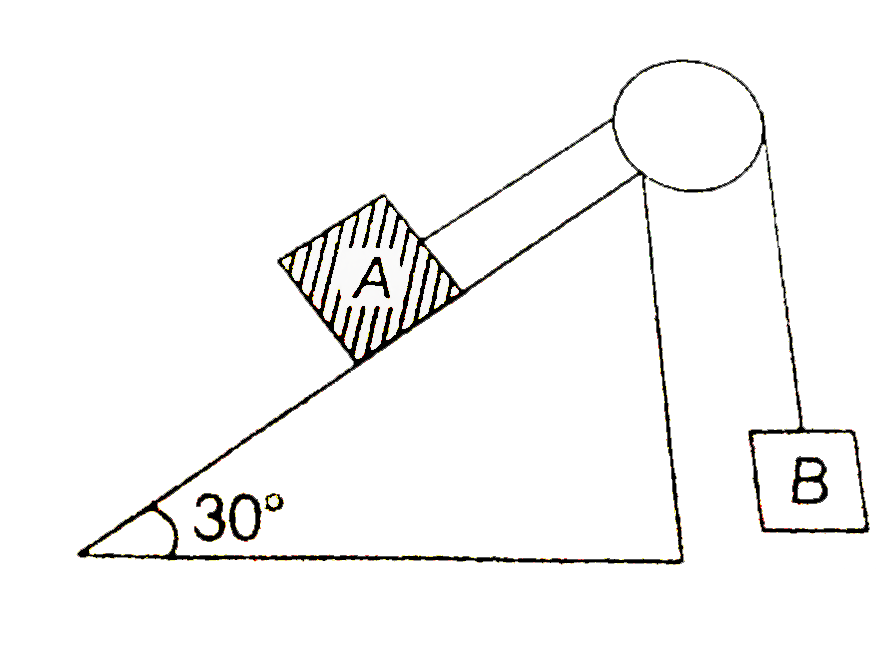What is the largest mass of C in kg that can be suspended without moving blocks A and B ? The static coefficent of friction for all plane surface of contact is 0.3 Mass of block A is 50kg and block B is 70kg. Neglect friction in the pulleys.

120kg
92kg
81kg
None of the above
The correct Answer is:C
Maximum value of friction between A and B
(f1)max=μN1=μmAg
=0.3×50×10
=150N
Maximum value of friction between B and ground
(f2)max=μN2=(mA+mB)g
=(0.3)(120)(10)=360N
force diagram is as shown below

T2=(f1)max=150N
T1=2T2+(f1)max+(f2)max
=300+150+360=810N
T1=mcg
∴mc=T1g=81010=81kg
Topper's Solved these Questions
- LAWS OF MOTIONBOOK - DC PANDEY ENGLISHCHAPTER - LAWS OF MOTIONEXERCISE - Objective Question
32 Videos
- LAWS OF MOTIONBOOK - DC PANDEY ENGLISHCHAPTER - LAWS OF MOTIONEXERCISE - Comprehension
9 Videos
- LAWS OF MOTIONBOOK - DC PANDEY ENGLISHCHAPTER - LAWS OF MOTIONEXERCISE - Assertion And Reason
28 Videos
- KINEMATICS 1BOOK - DC PANDEY ENGLISHCHAPTER - KINEMATICS 1EXERCISE - INTEGER_TYPE
15 Videos
- LAWS OF THERMODYNAMICSBOOK - DC PANDEY ENGLISHCHAPTER - LAWS OF THERMODYNAMICSEXERCISE - Level 2 Subjective
18 Videos
Similar Questions
Block of mass 10 kg is moving on inclined plane with constant velocity 10 m/s. The coedfficient of kinetic friction between incline plane and block is :-
View SolutionTwo blocks A and B are connected to each other by a string and a spring, the string passes over a frictionless pulley as shown in the figure. Block B slides over the horizontal top surface of a stationary block C and the block A slides along the vertical side of C, both with the same uniform speed. The coefficient of friction between the surfaces of blocks is 0.2. Force constant of the spring is 1960 newtons/m. If mass of block A is 2 kg. The mass of block B and the energy stored in the spring are _____ kg and _____ J.

View SolutionA block of mass 2 kg slides down an incline plane of inclination 30°. The coefficient of friction between block and plane is 0.5. The contact force between block and plank is :
View SolutionIn the figure shown, block of mass 2 kg is very long. Force of friction on 1 kg block is

View SolutionTwo blocksA andB are connected to each other by a string and a spring , the spring passes through a friction less pulley as shown in the figure . Block B slides over the horizontal top surface of a stationary block C both with the vertical side of C , both with the same uniform speed

The coefficient of friction between the surface the of block is 0.2 force constant of the spring is 1960 newtons/metre , if mass of block A is 2 kg , calculate the mass of block B and the energy stored is the spring ?
View SolutionCalculate the Force (F) required to cause the block of mass m1=20kg just to slide under the block of mass m2=10kg [ coefficient of friction μ=0⋅25 for all surfaces ]

View SolutionA force of 100 N is applied on a block of mass 3 kg as shown in figure. The coefficient of friction between the surface and the block is 14 .Then the friction force acting on the block is

View SolutionTwo blocks are connected over a massless pulley as shown in figure. The mass of block A is 10 kg and the coefficient of kinetic friction is 0.2 Block A sliders down the incline at constant speed. The mass of block B in kg is

View SolutionTwo blocks A and B of respective masses 6 kg and 4 kg are connected with a string passing over a light friction less pulley as shown in the figure . The coefficient of friction between the block A and horizontal surface is 0.4 . Then the minimum mass of block C which should be placed over A to prevent it from moving is :

View SolutionThe block A in the given figure is of mass 10√3 kg The coefficient of friction between the block and the surface on which it rests is 0.5. Find maximum mass of block B possible such that the system will be in equilibrium is.

View Solution
